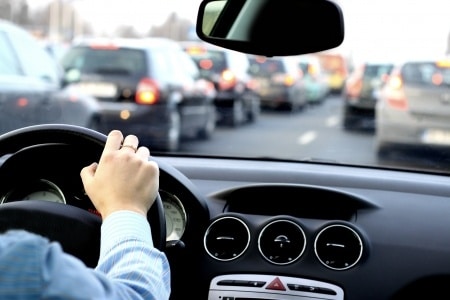Last updated on April 19th, 2024 at 12:46 pm
Living in this bustling metropolis that is Los Angeles offers us some unique opportunities to experiment with daily mindfulness. Traffic – it’s always there and provides endless occasions to look at the way our approach to a stressor effects our experience of it. Any driver confronting the 405 at rush hour is likely familiar with the torrent of negative thoughts and feelings that emerge. Because many of us spend so much time traveling to and from work in traffic-filled commutes, it is very powerful to make the best use of this time. By incorporating some daily mindfulness during our commutes, we can make a profound impact on how the rest of our day goes, which has ramifications that echo through our lives.
Mindfulness is distinguished from “auto-pilot” when we carry out actions without even being aware that we are doing them. Driving is an often-sited example of “auto-pilot” as we tend to tune out the drive, finding ourselves at our destination with little recall of how we got there. Mindfulness, on the other hand, involves paying attention, on purpose, non-judgmentally (Jon Kabat-Zinn, 2006).
Traffic can serve as a crucible to sharpen our present moment awareness. The experience of driving in rush hour is very evocative and typically elicits fairly predictable responses. These include feelings of irritation, frustration, tension and anger and negative thoughts about other drivers and perhaps yourself. We reach these highly aroused states with little awareness about how we got there. By bringing mindful attention to traffic, we can open up a space to make a choice about how we react.
Below are some ways to incorporate mindfulness into your car-time. Experiment with these and notice how they impact your experience of driving and other parts of your day.
1. Just before turning on your car, take five deep breaths. You can also do this just prior to exiting your vehicle when you’ve reached your destination.
2. Experiment with skipping the radio or music and allow your other senses to be fully engaged. This means noticing the sights and colors around you, observing the sounds of the cars, or even taking in the smell of the freeway.
3. Take note of the bodily sensations you are experiencing. Notice the quality of your breath, the grip of your hands on the steering wheel, any tension in your arms and shoulders. If you become aware of tension gently breath into the tense area and allow it to release with the out breath.
4. Try to expand your awareness. We tend to become myopically focused on what is just in front of us and ignore the entire vista. Try to carefully become aware of the cars and people around you and the nature or scenery in the background.
5. Take time to notice your attitudes and inner dialogue towards other drivers. You may be competitive or impatient, inwardly ridiculing or berating other drivers.
6. Smile inwardly and cultivate a friendliness towards your fellow humans on the road. A mantra taken from Buddhist metta meditation that may be helpful is, “May you be well, may you be happy.”
7. Use stoplights as opportunities to connect more deeply with the present moment, fully becoming aware of what is happening in our bodies and minds.
8. Try driving in the slow lane, consciously keeping your speed to slightly below the speed limit.
The reality of living in LA means that we are more than likely to be spending a good deal of time in our cars. We often find traffic inexplicable and overwhelmingly beyond our control. However, using drive time to cultivate mindfulness will greatly reduce stress and improve overall wellbeing. You might find yourself surprised at how much control you do have in the experience of driving.







